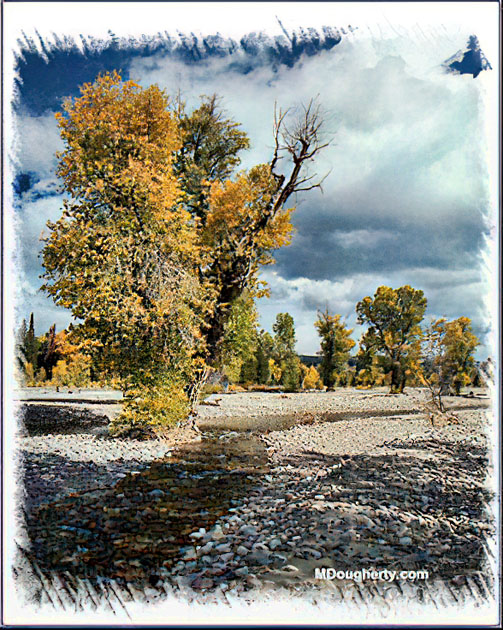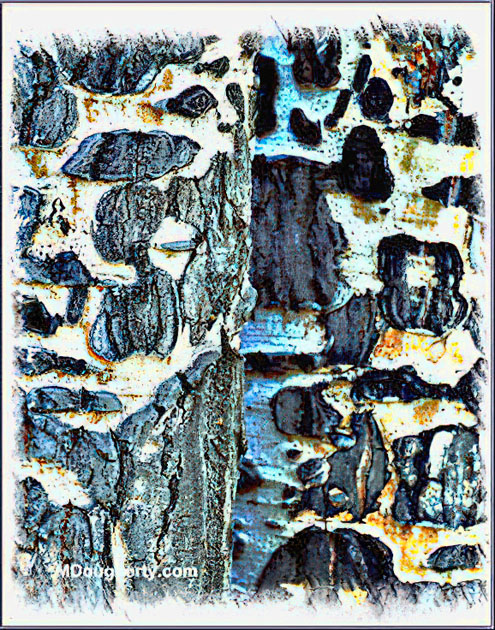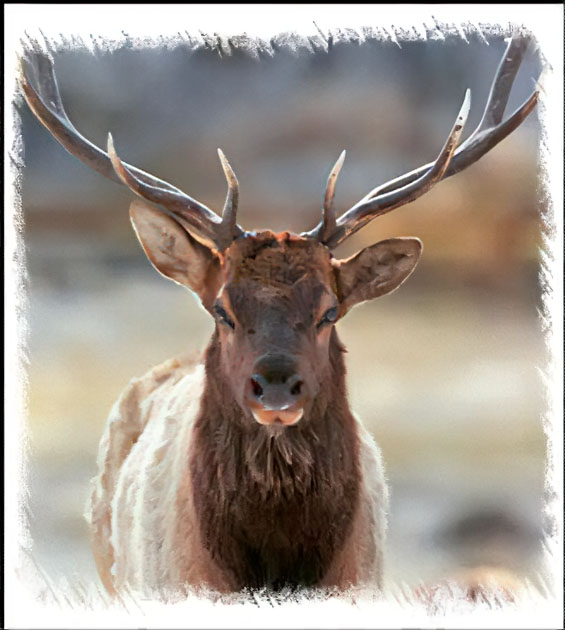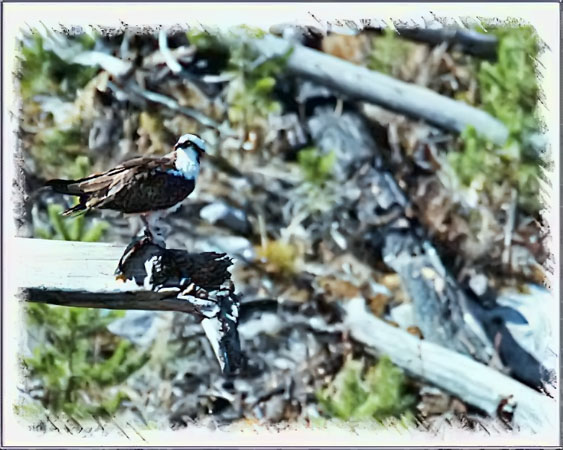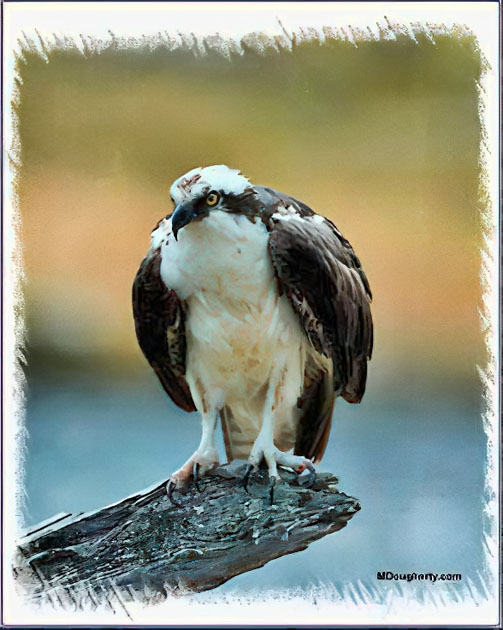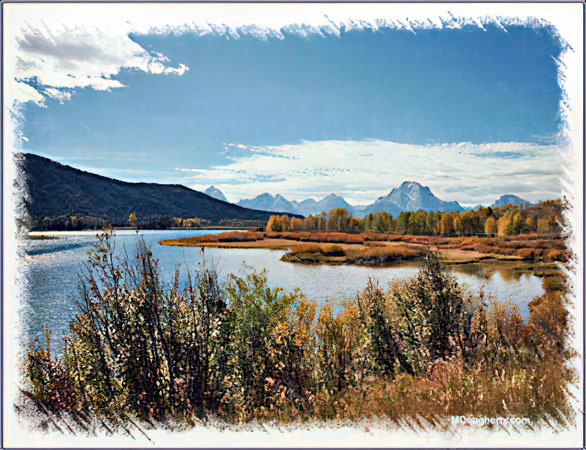|
|
|
|
Aspen
1.
|
Attended by photographic amateurs of varying skill levels, the forum succeeded greatly at getting the participants to the right place at the right time to maximize photo opportunities at the Park. All lodging accommodations at the Old Faithful Snow Lodge and travel within the Park were handled by the Forum operators, resulting in an excellent 3 day photo shoot.
|
|
2.
|
The drive from Yellowstone to the Grand Tetons was almost more exciting than visiting the Tetons themselves. Of course, this is an exaggeration but you don't generally have high photographic anticipation on your way to one of the most photogenic mountain peaks in the world. The turning of the aspen leaves and vivid cloud formations helped.
While a circular polarizing filter can really enhance the color of the aspen leaves, the polarizer can cause excess darkening of the blue sky at the top of the frame. The trick is to balance the amount of polarization of the aspen leaves with the blue sky.
|
|
3.
|
Finding patterns in nature is fun and challenging. Some patterns are readily evident, others are more ]discrete. The image at left was taken in a small grove of aspen where a lot of leaves were dangling in a small breeze and were back lit by the sun. The more obvious image was the grove, the leaves were not quite as obvious. A 500 MM lens was used to isolate the leaves from the rest of the grove but maintain a number of peripheral leaves in the same plane of focus.
Correct exposure was the greatest challenge of this image. A spot meter was used to calculate the exposure from one of the leaves. An exposure adjustment of opening up 1.5 stops was used since the bright yellow color tends to cause the meter to close down the exposure.
|
|
4.
|
Nothing subtle about this image. The bark is hard, the positioning of one trunk against the other is hard, so why not harden the image a little bit with unsharp mask. Note the orangish sap against the seemingly black and white bark.
|
|
5.
|
\
Just south of the Tetons is the National Elk Refuge. This area is fenced off to protect the elk during the winter. Unfortunately, there wasn't an elk in sight. The image at left was taken a few days earlier at Mammoth Hot Springs in Yellowstone. This guy was in rut, protecting his harem, and looked me straight in the eye. Notice his mouth.
To maintain a safe distance, I was using a 500 MM lens and was surrounded by numerous other photographers and tourists. The biggest challenge was capturing the image without other persons appearing in the image area. It would have been nice to capture an elk with a little geothermic activity in the background but this was difficult with so many other visitors at the time.
|
|
6.
|
When an osprey is sitting on a limb 100 yards distant, you capture whatever image you can get. Just finding the osprey sitting in a tree is half of the excitement of capturing the image. It's kind of neat scanning the trees searching for osprey. Sometimes, you might spot an old timer with eagle eyes who knows just where to look. Look carefully and you'll notice that the osprey is feeding on a fish.
The image is more an environmental image than an image of an osprey. This image was taken with a 500 mm lens with a 2x tele converter. Just holding down vibrations was challenge enough.
|
|
7.
|
This image was taken just prior to an image of the same osprey spreading his wings (prior to take off) in the Yellowstone section. This bird is in really good condition and sports massive claws. I feel really fortunate to have photographed this wild osprey.
One of the advantages of a 500 MM lens, other than its magnification of the subject, is the ability to isolate backgrounds. Half the challenge of this image was to position myself where I could capture the out of focus river (below) and the out of focus bank with orangish shrubs and grass (above).
|
|
8.
|
Having finally reached the Grand Tetons, the experience of viewing the Tetons is outstanding in and of itself. However, the first day, the weather was erratic and uncooperative. On a subsequent visit a few days later, the ranger service decided to perform a controlled burn up wind which basically wiped out all visibility in the valley. Sometimes you just need a little luck.
I tried to salvage at least one OK image by concentrating on the color in the foreground. I was not able to capture any acceptable images of the peaks themselves due to visibility problems. If the lack of visibility had been caused by storm conditions, I could have had some fun but the lack of visibility was caused by a smog like haze engulfing the entire valley in front of the Tetons.
|
|
9.
|
\
While most scenic photographs are taken in early morning or early evening, some images, especially those with some cloud formations, can survive being taken in the middle of the day.
Many of the best scenic images are taken with large format cameras. In fact it's a little intimidating using a 35 MM camera next to someone with a 8x10 view camera. (Time to bring out the 500 again.) Actually, the rapid improvement of 35 MM film and lenses in the last few years has really reduced the discrepancy in image quality.
The real advantage of a view camera is that the operator has to use a tripod which reduces camera movement and is an invaluable tool for creating better composition. The main disadvantage of a 35 MM lens is that it is so easy to take a picture without a tripod.
|

